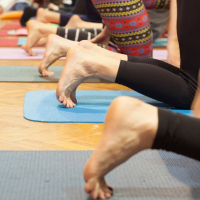
Fresh from a Pilates class, I’ve looked at the new Cochrane evidence on Pilates for low back pain and asked Chartered Physiotherapist and Pilates teacher Jane Callaway to explain more about Pilates and to share her thoughts on the evidence.
I went to my first Pilates class in over a decade last night. It reminded me that signing up for a class can give me the nudge I need to go and do some exercise when I’m not feeling like it and that it’s a sociable business; I smiled at several people I recognised from somewhere (where?!) and just hoped I wouldn’t be called on to remember their names. I hadn’t bargained on agonising cramp in one foot from the moment I put my foot on the mat and I’d forgotten that I rely on lipreading and would be unable to follow verbal instructions from our sideways/upside down positions. I had more excuse than most for allowing my mind to wander off onto plans for the weekend, whether I might be feeling a bit hungry and how near we might be to the bit at the end where you’re allowed to just lie there (I think I did that several times before we were supposed to).
It was good timing, anyway, as I’d been looking at new research on Pilates. I’m lucky not to be one of the many who suffer from non-specific low back pain (LBP), a major cause of disability and absence from work. It has been estimated that 40% of people with acute LBP will still have it a year on and, of those, 60% will still not have recovered a year after that.
Exercise is often recommended as a way of managing chronic LBP. These recommendations are supported by evidence for the benefits of exercise in general, but reliable information about the effectiveness of different types of exercise would help people make choices about what to try.
Now, a new Cochrane review has brought together the best available evidence on Pilates, which is being increasingly used by people with LBP. The reviewers were interested in the effect of Pilates on LBP in terms of any outcomes that could be considered patient-centred, rather than physiological measures such as muscle endurance or range of motion. But first, what is Pilates?
Click here to read Sarah Chapman's full blog on Evidently Cochrane. Also click here to read and share the accompanying blogshot.
